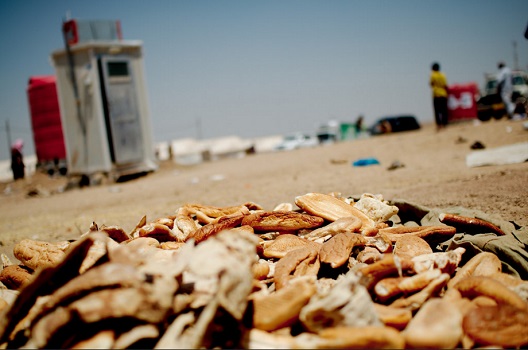 Ten million Syrians do not have enough food to eat, according to Oxfam. Rising food insecurity is a result of regime force and armed group tactics to put pressure on local populations and circumstantial situations outside of any one party’s control. Deliberate or not, civilians are struggling to secure basic staples such as bread and sugar. The main drivers of food insecurity are deteriorating government finances, use of food blockades to target civilian populations and fighters, destruction of agricultural infrastructure, and disruption to food transport.
Ten million Syrians do not have enough food to eat, according to Oxfam. Rising food insecurity is a result of regime force and armed group tactics to put pressure on local populations and circumstantial situations outside of any one party’s control. Deliberate or not, civilians are struggling to secure basic staples such as bread and sugar. The main drivers of food insecurity are deteriorating government finances, use of food blockades to target civilian populations and fighters, destruction of agricultural infrastructure, and disruption to food transport.
Syrians have not been uniformly affected. Access to food depends on where one lives, which party controls one’s city, town or even neighborhood, and how warring parties perceive the local population’s loyalties. Generally, populations living under or seen as friendly toward the regime are better off than those living under or believed to be favoring the opposition. The most visible and dramatic examples of deliberate food deprivation are sieges imposed by warring parties—usually by the regime—on hundreds of thousands of Syrians. Amnesty International reported in 2013 that the regime deliberately deprived between 17,000 and 20,000 people of food and medical supplies in Yarmouk camp alone.
Syrians in conflict-ridden territories such as Deir Ezzor, Aleppo, and Damascus appear to fare the worst. Regime forces imposed a blockade on Zabadani, which ended after 120 days when the warring parties reached a ceasefire. The regime forces then allowed food into the city it, but much of it was expired. According to the Zabadani local coordination committee, the residents’ immune systems had weakened under the four-month blockade, causing them to fall ill.
Further complicating the matter is that many donor countries, including the United States and Gulf countries, give food supplies directly to armed groups rather than civilians. Although given to support fighters, most armed groups have excess food and use it as a tool or weapon, depending on circumstances. For instance, one armed group in Hama reportedly gave food to the local school to encourage teachers and students to continue attending, whereas Saudi Arabia has given flour directly to armed groups, giving them the ability to control the operation of local bakeries.
The rising food insecurity goes beyond using food as a weapon. The rise in food prices in Syria accelerated sharply in early-2015 after the government reduced subsidies due to its weakening finances. The World Food Program (WFP) reports that bread prices increased by 66 percent in private bakeries and 87 percent in public bakeries. The cost and availability of food has left many Syrians without necessary nutrition. The WFP has tried to fill this gap by providing food baskets, but these baskets only provide a limited diet, deficient in fresh, vitamin-rich foods such as eggs, dairy, fruits, vegetables, and pulses. To make the issue worse, prices are increasing daily while the salaries of workers are stagnant at best. One Damascus resident by the name of Fatima claims, “If we don’t die from a stray missile, these prices are what will kill us. I used to get my salary and still have a little something at the end of the month but now a trip to the grocery store without buying any meat costs me 10,000 SYP [45 USD].”
Food security is far from uniform across the country. In the regime-controlled capital of Damascus, one kilogram (2.2 pounds) of bread costs 60 Syrian Pounds (SYP) (32 cents) on average—far cheaper than other Syrian cities like Deir Ezzor, where the same amount of bread costs 3500 SYP ($18.64). Clearly the sympathy or at least the passivity of Damascus residents is a regime priority, and accordingly the latter has provided affordable bread in the capital. By contrast, just eight miles from the city center, in the rebel-controlled suburbs, the prices of bread, flour, meat, sugar, and potatoes are the highest in the entire country. Regime forces have besieged the suburbs, while the armed group Jaish al-Islam that controls it has established a monopoly on food. In late-2014 protests broke out amid widespread hunger and accusations that the rebel group was hoarding food for its fighters.
Food insecurity is a side effect of the Syrian war. Fighting has blocked irrigation channels, destroyed greenhouses, and forced farmers to flee farmland causing a decrease in crop yield and an increase in food prices. Deliberate or unintentional disruptions to transport between cities has made food goods nearly unobtainable for many Syrians. According to the WFP, the transportation of produce has become cumbersome. For example, in the regime-controlled, coastal city of Tartous, traders in perishable goods, “estimate that wastage has doubled because of the expense and difficulty (due to insecurity and several checkpoints along the route which may demand that a truck be un-loaded before proceeding) of getting produce to large markets such as Damascus on time.” According to traders, the cost of transporting fruits and vegetables from Tartous in the northwest to Hasaka in the northeast has doubled.
The organization Justice for Life Observatory in Deir Ezzor discovered that hundreds of families are suffering from a shortage of bread in the besieged city’s neighborhoods. Currently, only three bakeries are operating in Deir Ezzor: al-Jazz, Khalid Bin al-Walid, and ad-Dahiyah. These bakeries allocate bread to security forces and intermediaries, who then sell the bread to the residents at a price of 350 SYP ($1.60) per bag. On the other hand, ISIS raised the price of a kilo of bread in the western countryside of Deir Ezzor last month from 100 to 120 SYP (52 cents to 60 cents). More recently, the residents of Aleppo were left stranded and prices for basic goods soared after an ISIS advance cut the sole route to regime-held areas of Aleppo. In other ISIS-controlled areas, such as the city of Al-Qantaniyah, bananas that used to sell for 50 SYP (26 cents) per kilo in 2011 now sell for 200 ($1). The price of 30 eggs has increased from 60-75 SYP prewar (29 to 40 cents) to roughly 650 SYP today ($3)
Numbers of killed ranging between 250,000 and 350,000 thousand are often bandied about, but these only refer to those who have died of direct war-related violence. The many other brutalities of war are often not counted due to difficulties in measuring them, but are often many times deadlier than direct violence. Malnutrition caused by sanctions killed as many as 576,000 Iraqi children from 1991-1995, far more than the Iraq war’s death by war-related violence toll of around 110,000 between 2003 and 2006. Local ceasefires, such as the one reached in Zabadani, are one possible solution where warring parties are deliberately withholding food. However, without a countrywide ceasefire, ensuring civilian security requires policy makers prioritize this issue and pressure belligerents to give aid workers access all populations and stop using food as an indiscriminate weapon of war.
Faysal Itani is a Resident Fellow with the Atlantic Council’s Rafik Hariri Center for the Middle East. Lena Abdin is an intern with the Rafik Hariri Center for the Middle East.
Image: (Photo: Flickr/Enno Lenze)

